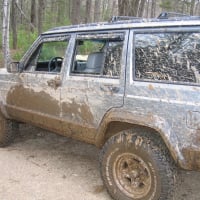Welcome! Here are the website rules, as well as some tips for using this forum.
Need to contact us? Visit https://heatinghelp.com/contact-us/.
Click here to Find a Contractor in your area.
If our community has helped you, please consider making a contribution to support this website. Thanks!
Cycles Per Hour Problem.
Options
Comments
-
-
@Jamie Hall the near boiler piping is insulated, but poorly. The way it is piped is completely wrong...no header and each main connects individually to each riser from the boiler.
I'm repiping it in the spring and will properly insulate it then.0 -
I vote for the 3 CPH as well. If the outside weather is a "typical" winter day for you, then I'd say the you have it in the sweet spot.
Also, having a warmer basement isn't necessarily a bad thing. It will keep the floor of the 1st floor warmer.
I've run experiments on my own system where I used a raspberry pi to track the burner state (open or closed) and the weather to see if various setting were more efficient or less efficient. Cutting to the end of the chase, it was impossible to tell because weather conditions caused the data to be too noisy and variable. If there is a difference, it's a percent or so and not easily confirmed in real world conditions.Burnham IN5PVNI Boiler, Single Pipe with 290 EDR
18 Ounce per Square Inch Gauge
Time Delay Relay in Series with Thermostat
Operating Pressure 0.3-0.5 Ounce per Square Inch0 -
@AdmiralYoda,
I made the move to more cycles per hour operation many years ago. I did it for comfort to get away from the annoying roller coaster of "screaming hot radiators then cold rooms long after" just as you say. I have ended up nearer 2 burns per hour than 3 on average and the CPH changes on its own being more like 2.5 the colder it gets.
I was prepared to pay more if necessary for the more even heat but was pleased to find it actually moderately more efficient.1926 1000EDR Mouat 2 pipe vapor system,1957 Bryant Boiler 463,000 BTU input, Natural vacuum operation with single solenoid vent, Custom PLC control0 -
Switch from Nest to Ecobee. You can get a couple wireless sensors to get a better average of your floor temperature than one thermostat sitting over the boiler room. Maybe you have a fire and can turn off the sensor in the living room so the rest of the house doesn't go cold. And download spreadsheets worth of data that Nest won't give you.
Add in @PMJ cycle timer and you'll be cooking to steam greatness.1 -
@Kjmass1. That is 100% the plan. My boiler is 40% oversized and will cycle on pressure when it's really cold or if I use a setback (which I don't anymore).
The delay timer and repiping the boiler will make this system about as efficient as it could ever be.
I don't have a C wire for my thermostat so may have to work around that or run a new line for the thermostat.0 -
My design load at 9F is 50k with a 200k boiler. I recommend running a C wire off a doorbell transformer, or I think they may have plug in wiring as well. You'll need 24v for the timer anyways.AdmiralYoda said:@Kjmass1. That is 100% the plan. My boiler is 40% oversized and will cycle on pressure when it's really cold or if I use a setback (which I don't anymore).
The delay timer and repiping the boiler will make this system about as efficient as it could ever be.
I don't have a C wire for my thermostat so may have to work around that or run a new line for the thermostat.
The timer really shines when it is arctic out- temps in the single digits. My radiators would be full and blasting out of the vents because they would fill up too quickly and thermostat hadn't responded to the heat yet. I'll set the timer to 10 minutes or less and it will just ping pong on and off all day.
0 -
I’ve got a related on my hot water radiant system. During transition period from day to evening, the Honeywell 9000 series tstat will call for heat for 10 minutes, cycle off for 10 minutes, then back on.
Digital display always shows same temp so must have tight control band and unit has no way to adjust CPS.I’m applying a similar solution to @PMJ but am using a DigiSet delay on break relay. The relay is designed to keep output powered for a set time after trigger (Tstat call for heat) goes low and will reset the timer if the trigger cycle during timeout period. The relay is configurable for times from .1 sec to 1023 sec (~17min), I’m planning to set for hold period of around 15 minutes. My boiler uses ODR to control water temp so running extra 15 minutes will not be a issue.0 -
@PC7060 , I find it annoying not being able to know what the logic is behind the smart thermostats when they do stuff. Sticking in a timer as you have makes it easy to take some control and know exactly what will happen. Many ways to approach this.Each situation a little different. Good show! Tell us about what you learn along the way.1926 1000EDR Mouat 2 pipe vapor system,1957 Bryant Boiler 463,000 BTU input, Natural vacuum operation with single solenoid vent, Custom PLC control1
-
I have a Lux TX500b. It has an adjustable swing setting from 1/4*f up to 2.25*f in quarter degree increments. I have it set to 1/2* swing and it seems very comfortable to me with reasonable on/off cycle times. Turn up the swing to 1* and I notice hot/cold periods with longer on and off times.
Dennis0 -
Agree @PMJ. Like the ease of monitoring but the black box aspect is frustrating. I’ll post a couple pic and let you know how it works out.PMJ said:@PC7060 , I find it annoying not being able to know what the logic is behind the smart thermostats when they do stuff. Sticking in a timer as you have makes it easy to take some control and know exactly what will happen. Many ways to approach this.Each situation a little different. Good show! Tell us about what you learn along the way.0 -
You guys should buy some BMS controllers and play around with them (I program BAS systems for a living).
I've implemented various digital anticipators over the years. Here's one.
It basically ramps the setpoint slowly between a min and max deadband. (0 to 1degC in this case).
So, immediately after call for heat starts, the deadband (overshoot to shut off) starts at 1degC but slowly ramps to 0deg over the ramp time (maybe 10-15min). This means it will have minimal overshoot assuming after a reasonable run time.
The same the happens while waiting for a call. Initially it would have to drop 1degC below setpoint (right after a call for heat is finished), but as the system sits off it ramps the deadband smaller and smaller to close to zero. This gives some very tight control once it's tuned and seems to work better than a PID loop.
You can tune the min and max deadband the the ramp rates.
I also put a min on/off timer on to prevent short cycles.
Re smart thermostats, tried the nest, got rid of it since the default deadband was too big and not adjustable. I'm curious about their "true radiant" feature which sounds like a anticipator implementation.
Ecobee gives you a bit more control but seems to have a very basic algorithm of just a adjustable deadband. Would love to see a more elegant approach to give the advantages of a old school anticipator.
I've found the honeywell vision pro stats (I think 8000 series) seem to have a pretty decent algorithm. Not sure what they do, but they cycle nicely without a lot of under/overshoot. Not a "smart" stat though.
2 -
I have this magic device. It's round, and is mounted on the wall... and has a little mercury vial in there attached to a bimetal, and a little heater which can be adjusted... and magically when it's adjusted right it responds correctly to the inherent delay of the big cast iron radiator...Br. Jamie, osb
Building superintendent/caretaker, 7200 sq. ft. historic house museum with dependencies in New England0
Categories
- All Categories
- 87.3K THE MAIN WALL
- 3.2K A-C, Heat Pumps & Refrigeration
- 61 Biomass
- 429 Carbon Monoxide Awareness
- 120 Chimneys & Flues
- 2.1K Domestic Hot Water
- 5.8K Gas Heating
- 114 Geothermal
- 166 Indoor-Air Quality
- 3.7K Oil Heating
- 77 Pipe Deterioration
- 1K Plumbing
- 6.5K Radiant Heating
- 395 Solar
- 15.7K Strictly Steam
- 3.4K Thermostats and Controls
- 56 Water Quality
- 51 Industry Classes
- 50 Job Opportunities
- 18 Recall Announcements








